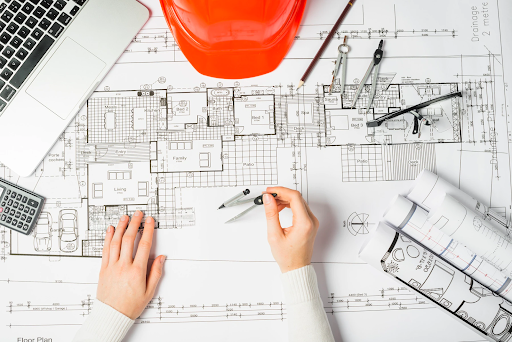Architect Portfolio Examples That Attract Clients Immediately
Architect Portfolio Examples That Attract Clients Immediately
Blog Article
Comprehending the Diverse Career Paths Available for Aspiring Architect
As a hopeful Architect, you have a globe of career courses waiting for you. Each course provides one-of-a-kind difficulties and possibilities to apply your creative thinking and technical expertise. Whether you're drawn to typical design or the subtleties of sustainable layout, there's a particular niche that aligns with your rate of interests. Recognizing these diverse choices can form your expert trip, but which direction will you pick to explore first?
Traditional Style: Creating Structures and buildings
Traditional style concentrates on creating structures and structures that mix capability with aesthetic charm. As you discover this area, you'll value the intricate equilibrium between type and function. You'll find out to draw inspiration from historical styles, incorporating aspects like balance, products, and workmanship. Your styles can mirror social heritage, showcasing neighborhood practices while meeting modern needs.
You'll create skills in drafting, model-making, and site analysis, permitting you to envision and connect your concepts properly. Involving with clients, you'll need to understand their vision and convert it right into practical styles.
Moreover, developing codes and sustainability methods are necessary in your job, ensuring your structures are secure and eco pleasant. As you grow in your career, you'll locate possibilities in household, industrial, and even restoration tasks, each offering special difficulties. Embracing traditional style leads the way for a fulfilling profession that pays tribute to the past while forming the future.
Urban Planning: Shaping Communities and Public Spaces
As an ambitious Architect, you can play a crucial function as an urban planner, changing exactly how areas engage and function. By utilizing community interaction techniques, you'll assure that locals have a voice fit their atmosphere. And also, integrating lasting design concepts will aid create rooms that not just satisfy today's needs however additionally protect the future.
Function of Urban Planners
While several may think about architects as the sole enthusiasts behind structures, urban coordinators play an essential function fit the broader landscape of neighborhoods and public rooms. They analyze land use, zoning regulations, and community needs to produce lasting environments that improve lifestyle. By teaming up with various stakeholders, you'll assist design parks, transportation systems, and residential areas that promote social communication and availability. Urban organizers likewise concentrate on environmental considerations, ensuring that developments integrate environment-friendly areas and support biodiversity. Your competence in spatial design and community dynamics allows you to envision future growth while preserving cultural heritage. In this vital duty, you'll straight affect exactly how individuals experience their environments, making every project an opportunity for favorable adjustment.
Neighborhood Engagement Approaches
Effective area interaction approaches are important for city coordinators to assure that the voices of locals are heard and valued in the planning process. To promote purposeful discussion, you ought to focus on open discussion forums and workshops where neighborhood members can share their concepts and problems. By proactively incorporating and listening feedback, you'll create spaces that reflect the community's needs, eventually leading to more lasting and successful metropolitan atmospheres.
Lasting Style Concepts
When making metropolitan areas, incorporating lasting style principles is crucial for developing atmospheres that flourish both environmentally and socially. Take into consideration integrating green rooms, like parks and yards, to boost biodiversity and enhance air high quality.
Creating with water conservation in mind is additionally vital-- consider rainfall yards and absorptive surface areas to take care of stormwater. Including area members during the preparation process warranties that the rooms you produce meet their demands and motivate social communication. By welcoming these principles, you'll add to dynamic, lasting metropolitan landscapes that profit everyone.

Landscape Design: Producing Sustainable Outdoor Settings
As you discover landscape style, you'll uncover necessary style concepts that create practical and lovely exterior rooms. Lasting techniques play an important role in making sure these settings prosper while decreasing environmental effect. Plus, you'll discover a range of occupation possibilities that enable you to make an actual distinction in exactly how individuals communicate with nature.
Layout Principles in Landscape
Recognizing design concepts in landscape architecture is essential for developing sustainable outside environments that integrate with nature. You'll need to contemplate components like equilibrium, proportion, and range to guarantee your designs feel cohesive and inviting. Including native plants not only improves biodiversity yet also minimizes water use, making your landscape resistant. Believe regarding the flow of space and just how individuals connect with it; pathways and seating locations must welcome expedition and leisure. In addition, pay focus to seasonal changes, designing with products that complement the environments year-round (Architect). By focusing on sustainability and aesthetic appeals, you can create exterior areas that enhance the community and promote wellness. Embracing these principles will certainly establish a solid structure for your occupation in landscape architecture.
Lasting Practices Introduction
Sustainable methods in landscape architecture not only concentrate on looks yet additionally focus on environmental health and resource preservation. By integrating native plants, you enhance biodiversity and lower the requirement for chemical plant foods and pesticides. Executing efficient watering systems aids save water and minimizes runoff, protecting nearby ecological communities. You can make spaces that advertise dirt health and wellness, such as utilizing natural products and practicing permaculture concepts. Furthermore, including green infrastructure, like rainfall yards and permeable sidewalks, aids in stormwater management and reduces city heat. You add to a much healthier planet and provide areas that cultivate community link when you create outside settings with sustainability in mind. Ultimately, these techniques guarantee your styles profit both people and the atmosphere for years to find.
Career Opportunities Exploration
With a strong structure in lasting techniques, landscape architecture provides a range of job paths that allow you to make a purposeful effect on the environment. You can work as a landscape developer, producing cosmetically pleasing and functional outside areas, or specialize in eco-friendly remediation, assisting to revitalize damaged ecosystems. Urban coordinators commonly team up with landscape architects to develop green spaces in city setups, boosting city livability. If you're passionate concerning education, take into consideration becoming a landscape architecture instructor, motivating future generations. Additionally, you may function with nonprofits concentrated on ecological sustainability or participate in research study to innovate brand-new techniques. Each course not just shapes attractive settings yet additionally promotes a healthier planet for future generations.
Lasting Style: Focusing on Eco-Friendly Practices
As you discover your occupation in style, accepting environmentally explanation friendly techniques can establish you apart in a competitive area. Lasting layout concentrates on producing buildings that reduce environmental influence while enhancing occupant well-being. By incorporating eco-friendly materials, energy-efficient systems, and lasting structure strategies, you'll contribute to a greener future.
Beginning by acquiring expertise of green qualifications like LEED or BREEAM, which can reinforce your qualifications. Think about just how all-natural light, ventilation, and thermal effectiveness can enhance design. Team up with designers and environmental specialists to introduce remedies that decrease waste and save sources.
Don't neglect the significance of area involvement-- appealing local stakeholders can motivate designs that integrate with the setting. As clients increasingly focus on sustainability, your experience in green techniques will not only draw in jobs yet additionally accomplish your passion for accountable style. Embrace this crucial facet of the profession, and enjoy your career thrive.
Historic Conservation: Securing and Recovering Social Heritage
While you begin on your building journey, think about the important function of historical preservation in keeping our cultural heritage. This area concentrates on the protection and reconstruction of substantial structures, sites, and frameworks that inform the tales of our past. By engaging in historical conservation, you'll help protect the building tradition that forms area identity.
As a historical conservation Architect, you'll evaluate historical significance and assess the condition of frameworks. You'll work carefully with guardians and chroniclers to guarantee genuine remediation methods are used. This occupation course permits you to mix creativity with research, allowing you to design remedies that appreciate initial materials and workmanship.
Your work not only adds to sustainability by reusing existing structures but additionally promotes a feeling of pride within areas. Accepting this course will certainly assist you come to be a guardian of background, preserving the tales and aesthetic appeals that enhance our lives.
Interior Architecture: Enhancing Indoor Spaces
Historic preservation and indoor architecture both share a commitment to boosting the built setting, but they concentrate on different facets. While historic conservation stresses maintaining a structure's historic and social value, interior design absolutely nos in on optimizing indoor areas for capability and appearances.
As an aspiring Architect, you'll locate that interior design enables you to mix creativity with technological abilities. You'll create spaces that not just look good but likewise advertise comfort and performance. This field involves understanding how light, shade, and products engage within a room, affecting state of mind and usability.
You'll deal with different jobs, from household homes to commercial offices, ensuring that each environment meets the demands of its passengers. By focusing on user experience, you can transform interiors into useful and motivating areas, making a substantial influence on just how individuals connect with their environments. Welcome the possibility to enhance indoor atmospheres and form the means individuals work and live.
Industrial Style: Combining Capability With Appearances
Industrial design plays a necessary role visit site in developing products that flawlessly mix aesthetic appeals with performance, guaranteeing that what you use day-to-day is not just visually enticing however likewise useful. As a hopeful Architect, you might involve on your own in this area, concentrating on creating every little thing from furnishings to consumer electronics. Your work includes comprehending individual requirements, materials, and producing processes, enabling you to create cutting-edge remedies that boost day-to-day experiences.
In industrial style, you'll commonly collaborate with producers, marketing experts, and designers, making sure that your styles are not only stunning but likewise viable. This career path offers a vibrant setting where imagination satisfies functionality, making it a gratifying choice for architects interested in shaping the items of tomorrow.
Often Asked Concerns
What Educational Qualifications Do I Required to Come To Be an Architect?
To come to be an engineer, you'll require an expert level in architecture, usually a Bachelor's or Master's. Furthermore, you'll have to complete an internship and pass the Architect Registration Evaluation to practice legitimately.
Exist Certification Demands for Different Building Occupation Paths?
Yes, there're certification requirements for numerous building paths. Architect. You'll need to pass see this exams, full teaching fellowships, and sometimes pursue specialized training, depending upon your picked focus, like landscape architecture, urban style, or historic preservation
What Software Program Skills Are Important for Architects Today?

How Can I Gain Practical Experience While Examining Style?
You can gain useful experience by interning at architectural firms, taking part in layout competitions, offering for community jobs, or teaming up with classmates on real-world assignments. These chances improve your abilities and build important links in the sector.
What Work Opportunities Exist Outdoors Conventional Design Firms?
You can discover various task opportunities outside conventional architecture firms, like city planning, interior decoration, landscape architecture, construction administration, property advancement, or perhaps duties in sustainability consulting. Each offers one-of-a-kind challenges and incentives.
Whether you're drawn to conventional style or the nuances of sustainable style, there's a specific niche that aligns with your passions.When creating metropolitan areas, including lasting style concepts is vital for creating settings that grow both environmentally and socially.As you check out landscape design, you'll discover vital design concepts that develop functional and beautiful outdoor spaces.Recognizing design concepts in landscape style is crucial for developing sustainable outside environments that harmonize with nature.In commercial style, you'll usually work together with engineers, manufacturers, and marketers, guaranteeing that your styles are not only gorgeous but additionally possible.
Report this page